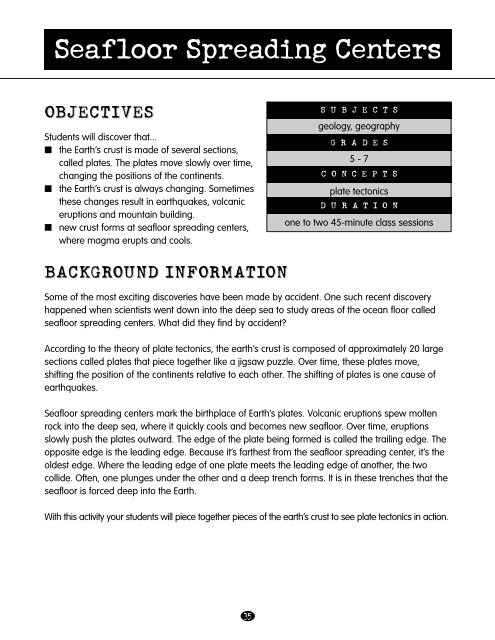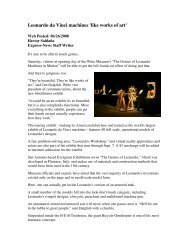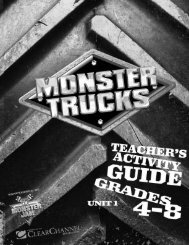Extreme Deep Teacher's Guide.pdf - Evergreen Exhibitions
Extreme Deep Teacher's Guide.pdf - Evergreen Exhibitions
Extreme Deep Teacher's Guide.pdf - Evergreen Exhibitions
Create successful ePaper yourself
Turn your PDF publications into a flip-book with our unique Google optimized e-Paper software.
Seafloor Spreading Centers<br />
OBJECTIVES<br />
Students will discover that...<br />
■ the Earth’s crust is made of several sections,<br />
called plates. The plates move slowly over time,<br />
changing the positions of the continents.<br />
■ the Earth’s crust is always changing. Sometimes<br />
these changes result in earthquakes, volcanic<br />
eruptions and mountain building.<br />
■ new crust forms at seafloor spreading centers,<br />
where magma erupts and cools.<br />
S U B J E C T S<br />
geology, geography<br />
G R A D E S<br />
5 - 7<br />
C O N C E P T S<br />
plate tectonics<br />
D U R A T I O N<br />
one to two 45-minute class sessions<br />
BACK<br />
CKGROUND INFORMA<br />
RMATION<br />
Some of the most exciting discoveries have been made by accident. One such recent discovery<br />
happened when scientists went down into the deep sea to study areas of the ocean floor called<br />
seafloor spreading centers. What did they find by accident?<br />
According to the theory of plate tectonics, the earth’s crust is composed of approximately 20 large<br />
sections called plates that piece together like a jigsaw puzzle. Over time, these plates move,<br />
shifting the position of the continents relative to each other. The shifting of plates is one cause of<br />
earthquakes.<br />
Seafloor spreading centers mark the birthplace of Earth’s plates. Volcanic eruptions spew molten<br />
rock into the deep sea, where it quickly cools and becomes new seafloor. Over time, eruptions<br />
slowly push the plates outward. The edge of the plate being formed is called the trailing edge. The<br />
opposite edge is the leading edge. Because it’s farthest from the seafloor spreading center, it’s the<br />
oldest edge. Where the leading edge of one plate meets the leading edge of another, the two<br />
collide. Often, one plunges under the other and a deep trench forms. It is in these trenches that the<br />
seafloor is forced deep into the Earth.<br />
With this activity your students will piece together pieces of the earth’s crust to see plate tectonics in action.<br />
35





